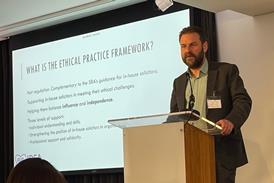The accountancy giants were coming for big-ticket legal work – until they weren’t, reports Katharine Freeland. So what now for the Big Four in law?
The low down
In 2023 it appeared that the Big Four accountants – Deloitte, PwC, EY and KPMG – were once again building up to challenge elite law firms with their own legal offerings. They had failed to make much of a dent in the 1990s. The most successful accountancy-linked firm, Garretts, went down with the Andersen mothership in 2002 after Enron sank, taking its auditor with it. However, it apparently made sense to again target the lucrative commercial legal market. The logic is simple. Accountants have many more ‘touch points’ with clients and are involved with corporate strategy from the outset. But conflicts are a problem – the curse of market dominance – and high-performing lawyers report that the loss of agency that would come with joining an accountancy-linked firm is a deterrent.
Deloitte Legal recently announced the hire of Nicola Brookes, former GC at global healthcare business GenesisCare. Working in a private-equity-backed company, coupled with tenure at Addleshaw Goddard and Eversheds, provided a mix of commercial and private practice experience that appealed to Deloitte.
Such hires were commonplace post-pandemic. In 2023, KPMG hired eight partners for its legal arm in London. Such hiring sprees are no more. At that time, the Big Four were advancing quickly into the legal market, aiming for a share of the core work of law firms in M&A due diligence, litigation and investigation support, and contract management. In 2023, revenue from their legal services arms generated $1.5bn, up from $900m in 2015 and $1.2bn in 2017, according to research by Thomson Reuters and Said Business School. EY was looking to triple lawyer headcount in the UK and Ireland in the next three years, while PwC was planning to double it.
Slash and burn
Two years later and the picture is very different. The rapid advance of artificial intelligence tools has led to the reappraisal of business structures across professional services. More importantly, the end of post-pandemic reorganisations and economic decline in key global markets means clients are reluctant to spend. Cuts have scythed across all Big Four business streams: audit and assurance, consulting and advisory, and tax and legal, with senior partner ranks bearing the brunt. EY cut deep after the 2023 collapse of its ambitious plan to sever its audit and consultancy businesses, Project Everest, into which it had heavily invested. EY Law’s Manchester-based legal services business EY Riverview Law closed. Its energy and projects team went to Hunton Andrew Kurth, the regulatory team to Squire Patton Boggs, and its technology and commercial law team to Browne Jacobson.
At Deloitte, most of the 29 partners who joined from intellectual property boutique Kemp Little in 2021 left within three years. ‘Between 2019 and 2024, the Big Four’s combined legal divisions hired 35 partners in London. Against this, the quartet lost 40 serving partners – including two-thirds of the laterals who joined during that time – to rival law firms,’ says Scott Gibson, founder of legal recruitment consultancy Edwards Gibson. These figures exclude the Kemp Little acquisition. Gibson points out that in 2024 the Big Four collectively announced just one partner hire in London: a construction partner moved from DLA to KPMG.
Last time round
The Big Four’s attempt to recruit legal talent and gain market share from the traditional law firms is not the first such land grab, of course. In the late 1990s and early 2000s, four of the then Big Five had tie-ups with named law firms, marking the beginning of speculation over their possible seizure of the corporate legal market. Arthur Andersen had Garretts, later Andersen Legal; PwC had Landwell; Ernst & Young (as was) had Tite & Lewis (which defected from PwC); and KPMG was aligned with Scottish firm McGrigors, before launching KLegal. The Enron scandal largely brought that arrangement – and Enron auditor Arthur Andersen – to an abrupt end.
The Legal Services Act of 2007 then gave the Big Four another opportunity to crack the lucrative legal market, allowing for the creation of alternative business structures that could be controlled and managed by non-lawyers. PwC Legal, KPMG Law and EY Legal launched in 2014. Deloitte Legal followed in 2018.
On paper, the marriage between the Big Four and legal should be a highly fruitful union, providing a range of services to clients that allow complex, multidisciplinary projects to be managed under one roof.
‘Three main features attract clients to the Big Four: global integration, multidisciplinary connectivity and competitive pricing,’ says Fiona Czerniawska, CEO of Source Global Research, which conducts market research and analysis on the management consultancy market.
The Big Four not only have global networks but their range of services also provides multiple entry points to decision-makers at the world’s biggest and most profitable businesses – not just through the GC, as with the traditional law firm. They are known for their investments in technology. PwC Legal lawyers can access My Structuring Lawyer, a proprietary document management and automation tool for reorganising international businesses; Deloitte has announced a link-up with AI platform Legora; and KPMG has its Digital Gateway.
‘In an era where we are seeing a profound technology shift in the industry, lawyers can benefit from the very significant technology investments that KPMG as a whole is making in its technology platform,’ says Stuart Bedford, global head of legal services for KPMG International.
There is, however, a huge problem. Commercial and legal conflicts, coupled with the need to separate auditing and other parts of the business, create obstacles that infuriate lawyers who must repeatedly turn down interesting work.
Big-ticket M&A, ‘bet the company’ litigation against any party apart from the government and even cybersecurity advice are often ‘conflicted out’, deterring rainmaker talent.
The dilemma that EY was trying to resolve with Project Everest is a very real one, exacerbated in the past decade by the stipulation that auditors must be rotated for public interest entities. Under the EU Regulation and Statutory Audit Directive 2014, implemented by the UK before its EU withdrawal, the maximum audit tenure for a public interest entity (a definition which in practice includes all large companies) is 10 years, which can be extended to 20 by way of mandatory tender. Under the US Sarbanes-Oxley Act, US-listed public companies are required to change auditors every five years. To give an idea of the impact of this change, before mandatory auditor rotation was introduced in the EU in 2017, Lloyds Banking Group had used PwC for 153 years. Relationships of over 100 years were not uncommon.
Counting down: 30 years of accountants in legal services
1990s – accountancy and consultancy firms enter the UK legal market through tie-ups with named firms.
2001 – Enron auditing scandal breaks, marking the end for US energy company Enron and its auditor Arthur Andersen, then one of the Big Five.
Early 2000s – accountancy and consultancy firms retreat from the legal market, due to restrictions on cross-selling professional services.
2007 – Legal Services Act is enacted, enabling non-lawyers to own, manage and take a profit from legal services.
2010s – rise of the alternative legal services provider disrupts the legal sector. Technology is deployed to offer cost-effective legal services and introduce different ways of working from the billable-hour model. Law firms start investing in advanced legal technology to automate documents and provide interactive tools to clients. Innovation teams and law firm-funded legal tech start-ups became a feature of the market.
2014 – PwC, KPMG and EY re-enter the UK legal market through alternative business structure licences – this time focused on providing tech-driven, cost-efficient legal services to clients traditionally serviced by the established mid-market firms.
2018 – Deloitte launches Deloitte Legal.
2019-2023 – Big Four increase headcount through the recruitment of private practice teams and boost revenue from their legal services.
2025 – economic downturn creates job losses across the Big Four, including their legal arms. EY pulls back from the brink of closing its UK legal operation. KPMG opens a legal services business in Arizona, building a bridgehead in what was a closed US market for non-lawyers.
Recruitment woes
There are other reasons why a career in a Big Four law firm would not appeal to lawyers used to private practice. Pay is commensurate with other segments of the Big Four business; hardly meagre by other industry standards but lower than many law firms. Partners can also lose their status as ‘partners’, becoming ‘directors’ or ‘principals’, a distinction that matters to some.
‘Lawyers can get locked into working for the Big Four,’ says one recruiter. ‘They lose their clients when they leave private practice. It is then hard for them to evolve their scope of work within the Big Four, where legal is a tiny segment compared to the dominance of the accountancy and audit business, and they fail to take clients with them if they leave.’
As dispersed global organisations, there is much bureaucracy at the Big Four. Decision-making about innovative steps or hires is often held up or stymied by the need for the approval of multiple, non-legal stakeholders.
As Gibson points out, none of this is helped by a reputation for a patronising attitude towards lawyers, who are used to being ‘king of the hill’ in the hierarchy of partnership in private practice.
The legal arms of the Big Four have also been unable to practise in the US, one of the world’s biggest legal markets. This changed in February when KPMG opened KPMG Law in Arizona. Since 2021, the state has allowed for ABSs, permitting non-lawyers to hold an ownership interest in legal services.
Bedford explains: ‘The US is the largest legal market in the world. By setting up a US firm, we have the ability to offer legal managed services and large global solutions, such as international group reorganisations and global entity management, to large US-headquartered corporates and financial institutions.’
Deloitte also has a legal business services arm in the US, focused on contract lifecycle management, legal entity management and AI transformation.
Any US legal arm is conflicted out of acting for the big clients they audit. ‘The danger is that the Big Four open in the US to do tech-heavy back-office processing work, which then sullies their brand when recruiting sharp legal talent,’ says one recruiter.
Where did it go so wrong?
Each Big Four incursion into law from the 1990s onwards has generated the same narrative: when and what they were going to take from the magic circle; and in their post-Enron iteration, when and what they were going to take from mid-market law firms. The Big Four has enviable access to blue-chip clientele, global reach, massive turnover and the best tech. Their seizure of substantial legal market share has always been considered only a matter of time – yet it has not happened.
'Private equity-backed accountancy firms have the scale, clients and delivery capability of the Big Four, but none of the regulatory handcuffs'
Jeff Zindani, Acquira Professional Services
Today, they are facing threats from agile challenger firms and fighting brand damage from repeated scandals, of which Deloitte’s Australian AI tax auditing matter is just the latest.
Some sector commentators, however, counsel that it is still wise for law firms to keep a close eye on what the accountants are up to. Jeff Zindani, managing director of Acquira Professional Services, says: ‘Now comes the real disruption. PE [private equity]-backed accountancy firms have the scale, clients and delivery capability of the Big Four, but none of the regulatory handcuffs. They can acquire law firms, industrialise delivery and build the legal platform the Big Four never could. If you’re looking for the real threat to traditional law firms, it’s not Deloitte or PwC etc. It’s the PE-backed accountancy networks coming up fast behind them.’
In the London legal sphere, the Big Four are assessing their losses, restructuring and standing back to survey the terrain. They see a more diverse landscape than when they relaunched into the market after 2007. Meanwhile, magic circle firms are pushing their expertise in compliance and risk management – former Big Four territory – and have invested in advanced legal tech, such as A&O Shearman’s ContractMatrix for AI-powered risk analysis. The accountants also have access to the world’s biggest legal market: the US. ‘Magic circle firms are diversifying but may not match the
Big Four’s multidisciplinary integration,’ says Czerniawska.

Another spin of the wheel
Success is not just measured by starring in blockbuster M&A or leading large-scale litigation, although these do hit the headlines. The emphasis is on being a ‘problem solver’, ‘trusted adviser’ or ‘strategic partner’ – counselling throughout, rather than tapdancing in from stage right for the showstopping deal. Digital transformation is now an imperative across client (and legal) businesses. This sits firmly within the Big Four repertoire. Legal instructions for Big Four law firms often serve clients who require legal advice within broader business projects, such as post-merger integration.
Czerniawska adds: ‘On the legal side, the Big Four have almost accidentally stumbled across an unmet client need and are filling it very successfully. They may be doing a large-scale change programme such as a supply chain management project, rebuilding factories and supply chains around the world, and the client will need legal advice on what they can and cannot do.’
Big Four legal teams build up valuable operational knowledge of the client, which allows them to take a more business-friendly approach to thinking about legal issues. ‘It’s not just a lawyer talking to a lawyer anymore,’ she says.
'On the legal side, the Big Four have almost accidentally stumbled across an unmet client need and are filling it very successfully'
Fiona Czerniawska, Source Global Research
This type of work is hard to measure in terms of market share gain from the traditional law firms. Instead, it could be viewed as a separate legal services market category: business integration and operational support.
‘Our legal professionals are part of a targeted, specialist practice that works closely with colleagues across tax, consulting and deals, enabling them to deliver integrated, multidisciplinary solutions to clients,’ explains Yvonne Cypher, head of legal business solutions at PwC UK. Cypher considers this collaborative approach to
be the key differentiator between their offering and private practice. ‘This allows lawyers to work on complex, cross-functional projects that are increasingly in demand as clients seek holistic support in areas like carve-outs, global restructuring, regulatory compliance, technology transformation and ESG,’ she says.
Could this be the foundation for a parallel – rather than directly competing – legal business model that cracks the market? One issue the Big Four will need to address is the level of churn in their legal practices. Considering how to attract and retain the best legal talent is imperative.
‘They have been consistently hiring the wrong people,’ says one recruiter. ‘And at the moment, they don’t understand lawyers and how they work.’
There may be scope for yet another resurrection of the Big Four’s once grand legal ambitions. Only this time, instead of eyeing up the magic circle’s lunch or that of the mid-market, perhaps they will be cooking their own.

Katharine Freeland is a freelance journalist
































No comments yet